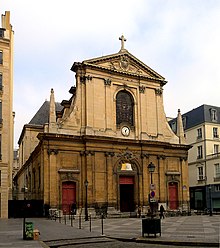Basilica of Notre-Dame-des-Victoires, Paris
| Notre-Dame des Victoires | |
|---|---|

Notre-Dame des Victoires
|
|
| Basic information | |
| Location | 6 Rue Notre Dame des Victoires, 2e |
| Geographic coordinates | 48°52′0″N 2°20′27″E / 48.86667°N 2.34083°ECoordinates: 48°52′0″N 2°20′27″E / 48.86667°N 2.34083°E |
| Affiliation | Catholic Church |
| Rite | Roman Rite |
| State | France |
| Province | Archdiocese of Paris |
| Region | Île-de-France |
| Status | Active |
| Heritage designation | 1972 |
| Website | www |
| Architectural description | |
| Architectural type | Church |
| Architectural style | Baroque |
| Groundbreaking | 1629 |
| Completed | 1740 |
Located at 6, rue Notre-Dame-des-Victoires, in the 2nd arrondissement of Paris, Notre-Dame-des-Victoires is one of ten minor basilicas located in the Île-de-France region of France. The closest Metro station is 'Bourse'.
In 1619 the Discalced Augustinians (colloquially referred to as the "Petits Pères") established their convent, Notre-Dame-des-Victoires, on three hectares of land they had purchased by the bourse (market) of the city, located at the intersection of the Place des Petits-Pères and Rue de la Banque. Notre Dame des Victoires is the former chapel of the Augustinian fathers (Petits-Pères), built in the years 1629-1740.
On December 8, 1629 the foundations were blessed by the Archbishop of Paris, Jean-François de Gondi. The next day, King Louis XIII himself laid the cornerstone in the presence of the Court's 'seigneurs' and the city's officials. The construction was funded by King Louis on the condition that it be dedicated to his victory over the Protestants at La Rochelle, which he attributed to the intercession of the Blessed Mother.
The first church being too small, reconstruction commenced in 1656 according to the plans of Pierre Le Muet. Libéral Bruant, Robert Boudin, and Gabriel Leduc oversaw this work. The new church, not yet completed, was consecrated in 1666. Work was finalized in 1737 under the supervision of Sylvain Cartaud. He oversaw the expansion of the nave, the construction of the façade as well as the construction of the transept's striking spherical roof.
The sanctuary is graced by several paintings by the French painter Louis-Michel van Loo (1707–1771).
A large garden and a double-cloister existed at the site until the Revolution. At that time, they were confiscated and fell into disuse. The church was converted into the home of the national lottery and a stock exchange during the Directory, but was returned to the practice of worship under the First Empire.
...
Wikipedia
